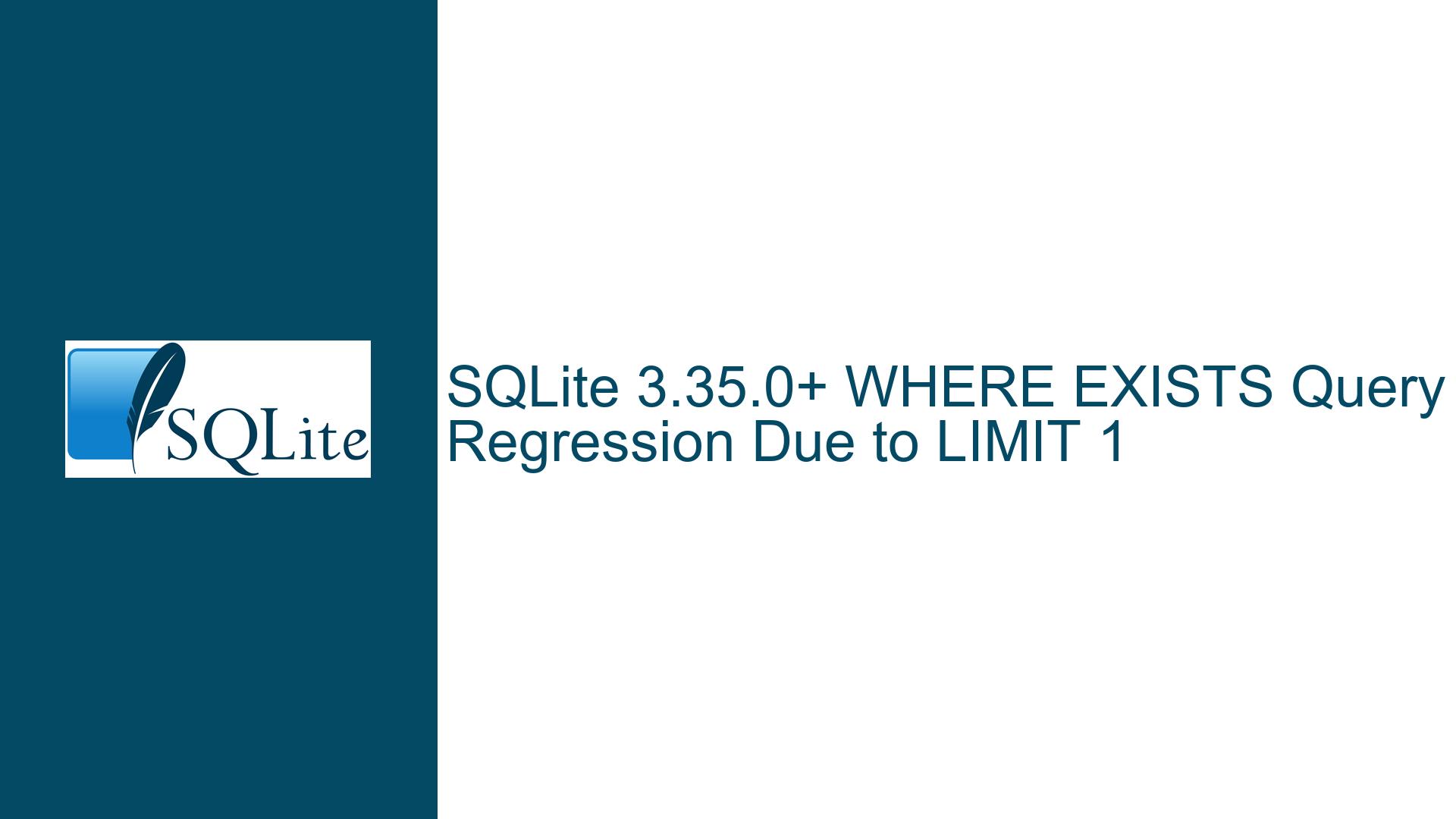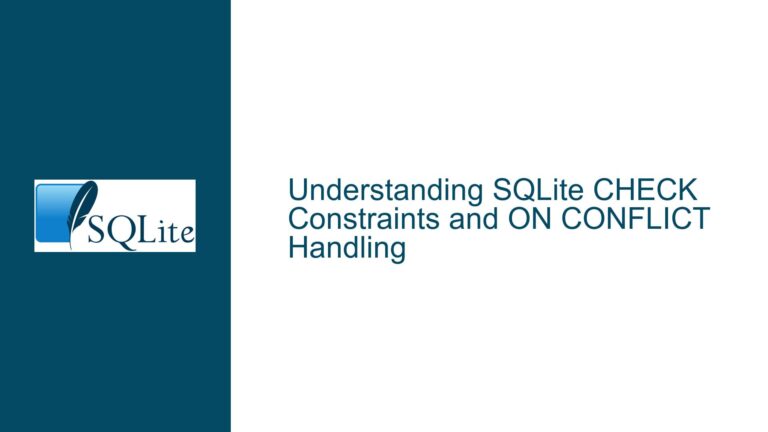SQLite 3.35.0+ WHERE EXISTS Query Regression Due to LIMIT 1
Incorrect Query Results with EXISTS and LIMIT 1 in SQLite 3.35.0+
A regression was introduced in SQLite version 3.35.0 that affects queries using the EXISTS operator in the WHERE clause when combined with LIMIT 1. Specifically, the query returns incorrect results when the EXISTS subquery includes a LIMIT 1 clause. This issue was identified in the context of a Django test suite, where a query that previously returned three rows in SQLite 3.34.0 and earlier versions returned only one row in SQLite 3.35.3. The problem was traced back to an optimization introduced in SQLite 3.35.0 that attempts to process EXISTS operators in the WHERE clause as if they were IN operators, under certain conditions.
The issue manifests when the EXISTS subquery is used to filter rows based on a condition that involves a foreign key relationship. In the provided example, the query is designed to select employees who are either CEOs or points of contact for companies. The query uses two EXISTS subqueries, each with a LIMIT 1 clause, to check if an employee is referenced in the ceo_id or point_of_contact_id columns of the expressions_company table. In SQLite 3.35.0+, the query incorrectly returns only one row instead of the expected three rows.
The regression was fixed in SQLite 3.35.4, as documented in the release notes. However, understanding the root cause, the conditions under which the issue occurs, and the steps to mitigate or resolve it is crucial for developers working with SQLite versions 3.35.0 to 3.35.3.
Optimization of EXISTS as IN Leading to Incorrect Query Results
The root cause of the issue lies in an optimization introduced in SQLite 3.35.0 that attempts to process EXISTS operators in the WHERE clause as if they were IN operators. This optimization is intended to improve query performance by transforming EXISTS subqueries into equivalent IN subqueries, which can be more efficiently executed in certain cases. However, this transformation is not always valid, particularly when the EXISTS subquery includes a LIMIT 1 clause.
The optimization assumes that the EXISTS subquery can be safely rewritten as an IN subquery without altering the semantics of the query. However, this assumption breaks down when the LIMIT 1 clause is present, as it introduces a constraint that is not accounted for in the transformation. Specifically, the LIMIT 1 clause ensures that the subquery returns at most one row, which can affect the overall result set of the query. When the optimization is applied, the LIMIT 1 clause is effectively ignored, leading to incorrect results.
In the provided example, the query uses two EXISTS subqueries to filter employees based on whether they are referenced in the ceo_id or point_of_contact_id columns of the expressions_company table. Each subquery includes a LIMIT 1 clause to ensure that the subquery returns at most one row. In SQLite 3.35.0+, the optimization incorrectly transforms these EXISTS subqueries into IN subqueries, ignoring the LIMIT 1 clause and causing the query to return only one row instead of the expected three rows.
The issue was exacerbated by the fact that the optimization was applied even when it was not safe to do so. The SQLite development team acknowledged the problem and fixed it in version 3.35.4 by ensuring that the optimization is only applied when it is safe to do so, particularly when the LIMIT 1 clause is present.
Upgrading to SQLite 3.35.4 and Testing Against Pre-Release Versions
The most straightforward solution to the issue is to upgrade to SQLite version 3.35.4 or later, where the regression has been fixed. Developers using SQLite 3.35.0 to 3.35.3 should upgrade to the latest version to avoid encountering this issue. However, upgrading may not always be immediately feasible, particularly in production environments where thorough testing is required before deploying a new version of SQLite.
For developers who cannot immediately upgrade, a workaround is to remove the LIMIT 1 clause from the EXISTS subqueries. In the provided example, removing the LIMIT 1 clause from both EXISTS subqueries results in the query returning the correct results in SQLite 3.35.3. However, this workaround may not be suitable in all cases, particularly when the LIMIT 1 clause is necessary to ensure the correct behavior of the query.
To prevent similar issues in the future, developers are encouraged to test their applications against pre-release versions of SQLite. The SQLite development team provides several options for accessing pre-release versions, including downloading the latest trunk version from the SQLite website or cloning the Fossil repository. Testing against pre-release versions allows developers to identify and report issues before they are introduced into stable releases, helping to ensure the stability and reliability of their applications.
The SQLite development team also provides pre-release snapshots on the SQLite download page, which include pre-built sqlite3.c and sqlite3.h files. These snapshots are particularly useful for continuous integration (CI) testing, as they allow developers to automatically test their applications against the latest version of SQLite without manually updating the URL in their CI configuration. By incorporating pre-release testing into their CI pipelines, developers can catch regressions and other issues early, reducing the risk of encountering problems in production.
In conclusion, the regression introduced in SQLite 3.35.0 that affects queries using EXISTS with LIMIT 1 in the WHERE clause is a significant issue that can lead to incorrect query results. The root cause of the issue lies in an optimization that incorrectly transforms EXISTS subqueries into IN subqueries, ignoring the LIMIT 1 clause. The issue was fixed in SQLite 3.35.4, and developers are encouraged to upgrade to the latest version to avoid encountering this problem. For those who cannot immediately upgrade, removing the LIMIT 1 clause from the EXISTS subqueries is a viable workaround. Additionally, testing against pre-release versions of SQLite can help identify and report issues before they are introduced into stable releases, ensuring the stability and reliability of applications that rely on SQLite.






